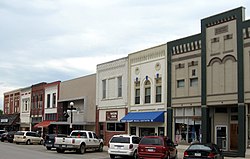Harlan, Iowa
| Harlan, Iowa | |
|---|---|
| City | |

Downtown Harlan
|
|
 Location of Harlan, Iowa |
|
| Coordinates: 41°39′17″N 95°19′19″W / 41.65472°N 95.32194°WCoordinates: 41°39′17″N 95°19′19″W / 41.65472°N 95.32194°W | |
| Country |
|
| State |
|
| County | Shelby |
| Area | |
| • Total | 4.39 sq mi (11.37 km2) |
| • Land | 4.39 sq mi (11.37 km2) |
| • Water | 0 sq mi (0 km2) |
| Elevation | 1,253 ft (382 m) |
| Population (2010) | |
| • Total | 5,106 |
| • Estimate (2012) | 5,085 |
| • Density | 1,163.1/sq mi (449.1/km2) |
| Time zone | Central (CST) (UTC-6) |
| • Summer (DST) | CDT (UTC-5) |
| ZIP codes | 51537, 51593 |
| Area code(s) | 712 |
| FIPS code | 19-34500 |
| GNIS feature ID | 0457259 |
| Website | City of Harlan |
Harlan is a city in Shelby County, Iowa, United States, along the West Nishnabotna River. The population was 5,106 at the 2010 census. It is the county seat of Shelby County.
Harlan was platted in 1858. It was named for one of Iowa's early U.S. Senators, James Harlan. Harlan was designated county seat in 1859. The town was incorporated on May 2, 1879.
Harlan's longitude and latitude coordinates
in decimal form are 41.654609, -95.322019.
According to the United States Census Bureau, the city has a total area of 4.39 square miles (11.37 km2), all of it land.
As of the census of 2010, there were 5,106 people, 2,222 households, and 1,341 families residing in the city. The population density was 1,163.1 inhabitants per square mile (449.1/km2). There were 2,410 housing units at an average density of 549.0 per square mile (212.0/km2). The racial makeup of the city was 97.0% White, 0.5% African American, 0.4% Native American, 0.6% Asian, 0.6% from other races, and 0.9% from two or more races. Hispanic or Latino of any race were 1.9% of the population.
There were 2,222 households of which 26.7% had children under the age of 18 living with them, 47.8% were married couples living together, 9.7% had a female householder with no husband present, 2.8% had a male householder with no wife present, and 39.6% were non-families. 34.2% of all households were made up of individuals and 17.7% had someone living alone who was 65 years of age or older. The average household size was 2.26 and the average family size was 2.88.
...
Wikipedia
